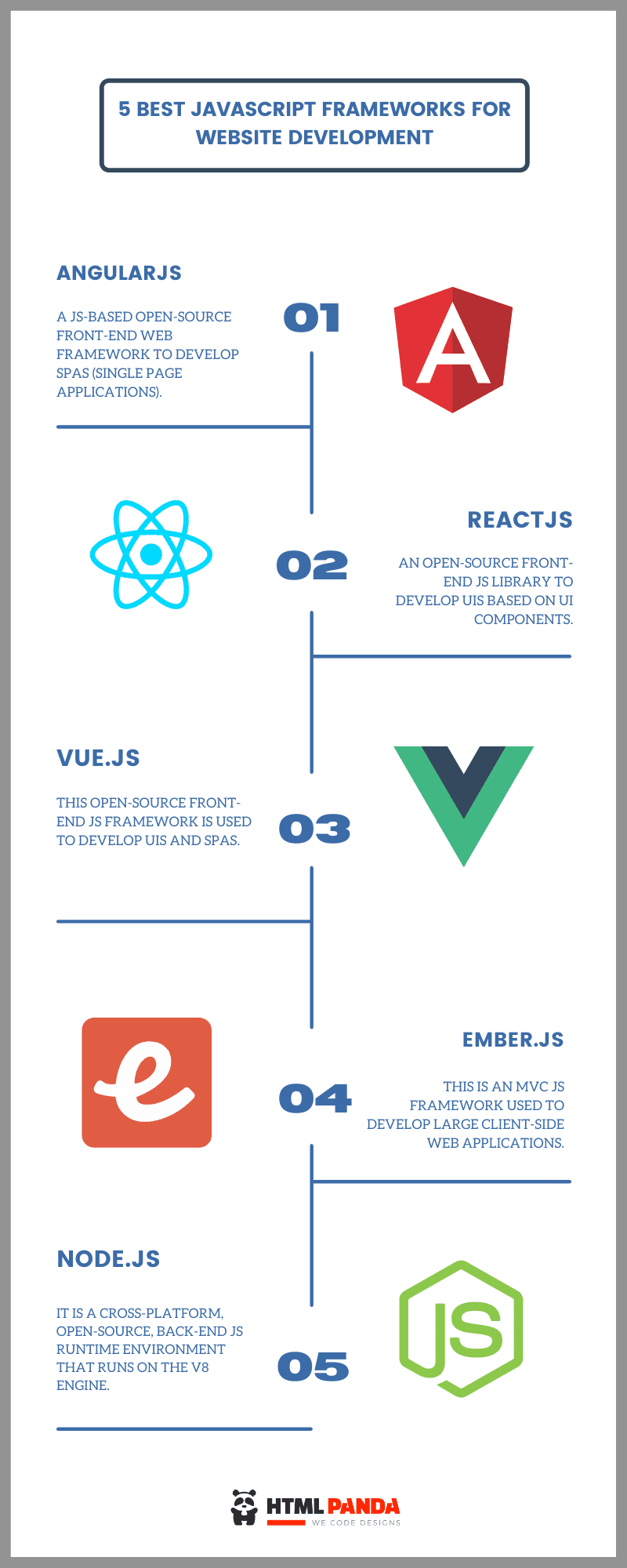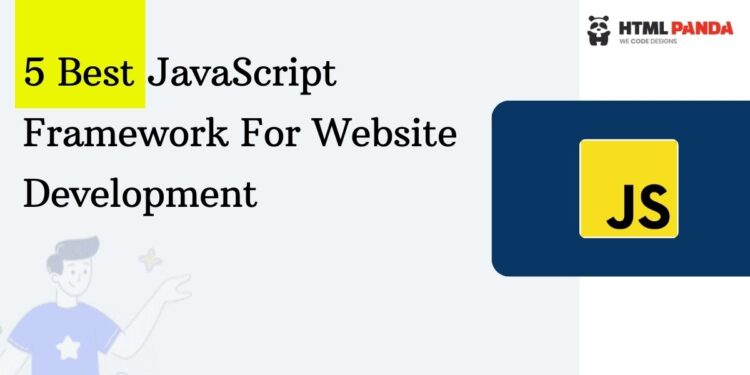JavaScript is a widely used technology for developing interactive websites or web apps.
As per w3techs –
“JavaScript is used as a client-side programming language by 97.3% of all the websites.”
It is enough to tell the popularity of this programming language. The widespread use of JavaScript makes JavaScript development services recognized among web development partners.
In addition to the extensive benefits, JavaScript offers various frameworks to develop complex web applications faster and more efficiently.
The list of frameworks keeps on growing. While selecting a relevant framework for your website development, match your project requirements with the framework’s features to choose the best among various options.
For ease, we have curated the list of the top five JavaScript frameworks that come with top-notch features.
Stay tuned to the blog post to learn the top JavaScript frameworks that will continue to be popular in 2024 and even in the next coming years.
What is a JavaScript Framework?
A JS framework is a set of JS code libraries. It is a tool that makes working with JavaScript smoother and more manageable. Besides, JS frameworks facilitate a programmer to code a device-responsive web application.
Besides, JS frameworks come with a set of rules and guidelines to help any developer make complex web applications efficiently and quickly.
However, you can consider our guide on JavaScript website development to have a better insight into this programming language.
What Makes a JS Framework Different From a JS Library?
It could be considered a common topic of discussion in the software community. The key difference between both terms is that libraries include functions that can be called to perform a task, whereas a framework defines the flow of software and tells developers what it requires.
In a library, the code is going to call the library, whereas, in a framework, the code is being called by the framework.
If we talk about JS libraries, they are the collection of code designed for particular use cases. For instance, jQuery is a JS library that streamlines the DOM traversal syntax, animation, event handling, and other common tasks.
In contrast, JS frameworks are built to accomplish various functions and form the backbone of a web application.
Top 5 JavaScript Frameworks For Website Development
 AngularJS
AngularJS
It is one of the most robust, and open-source JavaScript frameworks. It tops the list when we talk about developing sophisticated and efficient single-page applications (SPAs).
You must not forget to read this AngularJS web development guide to know what makes it a good fit for your web development projects.
It made a good name among the developer community because of its high speed and amazing performance.
This JS framework uses the concept of data binding, which automatically synchronizes the data between the client and the database, which helps developers from having to define requests and responses whenever a user interacts with the UI.
Features of AngularJS
The core features of AngularJS are given as follows –
-
- Data-Binding – Using AngularJS, you don’t have to write any special code to bind data to the HTML controls. It automatically synchronizes the data between the model and view components.
- Services – AngularJS comes with various built-in services like $http for making XMLHttpRequests.
- Model View Whatever (MVW) – AngularJS supports MVC or Model-View-Whatever (MVW) architecture. MVW is a design pattern to divide an application into different parts called Model, View, and Controller, each with different responsibilities.
- Dependency Injection – A built-in dependency injection subsystem in AngularJS helps the developer easily create, test, and understand the applications.
- Directives – One of the unique functionalities of AngularJS is directives that make it unique among other frameworks. AngularJS includes built-in directives like ngModel, ngBind, etc.
ReactJS
ReactJS is a fast, reusable, and scalable JavaScript library to build interactive and user-friendly interfaces (UIs). A team of Facebook developers develops it.
It creates efficient memory data structures in an organized manner that updates and computes the changes in the browser. It enables a JavaScript development company to use each module within the web app. It ultimately decreases the development time.
Features of ReactJS
The core features of ReactJS are given as follows –
- JSX-Based Design Architecture – JSX stands for ‘JavaScript XML’ which is a markup syntax very similar to HTML. It makes writing the React components easier by injecting syntax like HTML into the web page.
- Component-Based – In ReactJS, a web page’s component is divided into small components to create user interfaces. Each part of the web application would be encapsulated in a self-contained module called a component.
- Declarative UI Library – ReactJS updates efficiently and renders the right components when data changes. Moreover, declarative views make it easy to read and debug the code.
- Virtual DOM – A virtual DOM object represents the original DOM object. When any change happens in the web application, the complete UI is re-rendered in the virtual DOM representation.
- Performance – One of the major reasons behind the good performance of ReactJS is virtual DOM, as it compares the new data with the original DOM and automatically updates the view.
Vue.js
It is another open-source progressive JS framework for building UIs. It is also the most user-friendly framework for both programmers and non-programmers.
This front-end JS framework helps you quickly and efficiently develop SPAs and PWAs.
It is easy to learn and comes with good documentation that makes it best for beginners. It can be learned in a few days if you have prior familiarity with front-end web programming. It is a much more reliable framework to develop cross-platform web apps.
Features of Vue.js
The core features of Vue.js are given as follows –
- CSS Transitions and Animations – While adding/updating or removing HTML elements from the DOM, VueJS provides various ways to apply a transition to them.
- Templates – VueJS offers HTML-based templates that are compiled into Virtual DOM Render functions. These templates bind the DOM to Vue instance data. One can use the templates of the render functions, and for that, they need to replace the template with the render function.
- Directives – VueJS has built-in directives like v-if, v-else, v-bind, v-model, etc., that allow us to perform multiple actions on the front end.
- Virtual DOM – Like ReactJS, VueJS also uses Virtual DOM. The changes do not happen to the DOM; instead, a replica is created that is present in the form of JS data structures.
- Components – These are the vital feature of VueJS that help to create custom elements that can be used in HTML.
Ember.js
It is an open-source JS client-side framework that is used to develop web applications. It lets developers create client-side JS applications by offering a complete solution that contains an application flow and data management.
Ember.js is best for creating scalable single-page web applications. It is suitable for long-lived projects and a recommended framework for projects that need a web application with a desktop-like UI and experience.
Features of Ember.js
The core features of Ember.js are given as follows –
- Routing – Ember.js has a built-in router that includes asynchronous data loading with query parameters and dynamic URL sections. Along with that, it also supports nested URLs.
- Testing – Though by default, a completely equipped modern test harness is built into every application. Ember.js supports unit tests, application tests, and rendering tests.
- Easy Upgrades – Ember.js has fast and straightforward upgrades.
- Build Pipeline – There is a built-in development environment that enables test runner, auto-reload, and fast rebuilds.
- Performance – Ember.js is built on one of the fastest rendering engines, i.e., Glimmer. It compiles templates to a highly-performant virtual machine.
Node.js
Node.js is an open-source and server-side JS runtime platform that runs on multiple platforms. It is built on Google Chrome’s JS Engine (V8 Engine).
It works with a microservices architecture and is best for building scalable network applications. It uses an event-driven, asynchronous, non-blocking I/O model, making it efficient and lightweight.
It also provides a rich library of various JS modules that simplifies web application development.
Features of Node.js
The core features of Node.js are given as follows –
- Very Fast – Node.js library is very fast in executing the code as it is built on Chrome’s V8 JS Engine.
- Single-Threaded but Highly Scalable – With event looping, Node.js uses a single-threaded model. The same program can provide service to many requests compared to traditional servers such as Apache HTTP Server.
- No Buffering – Node.js applications never buffer any data. These applications output the data in chunks due to the callback function concept. So, the user quickly receives more data, as it does not have to wait to complete the entire operation.
- Caching – Node.js supports the caching of modules. When a module in Node.js is requested for the first time, it is cached in the application memory. Caching allows the applications to load web pages faster and respond easily to the user.
- Performance – Node.js is created on chrome’s V8 JS engine that compiles the JS code into machine code and makes it easier and faster to implement.
Moreover, if you are less technically sound and require a secure and high-performance website, you can also connect with a JavaScript development company. Their professionals will thoroughly analyze the business requirements and provide you with the best web solution for your business.
Conclusion
So, these were the top JS frameworks that come with an array of features and are used by top brands in the market. If you are looking for hassle-free web development, you can consider any of the above-mentioned JS frameworks.
You can even invest in JavaScript web development to effectively serve your purpose.
Besides, as mentioned before, finalizing the proper JS framework for your business, first consider your business requirements and the type of web app you want to develop. After that match, your needs with framework features to make an informed decision.













